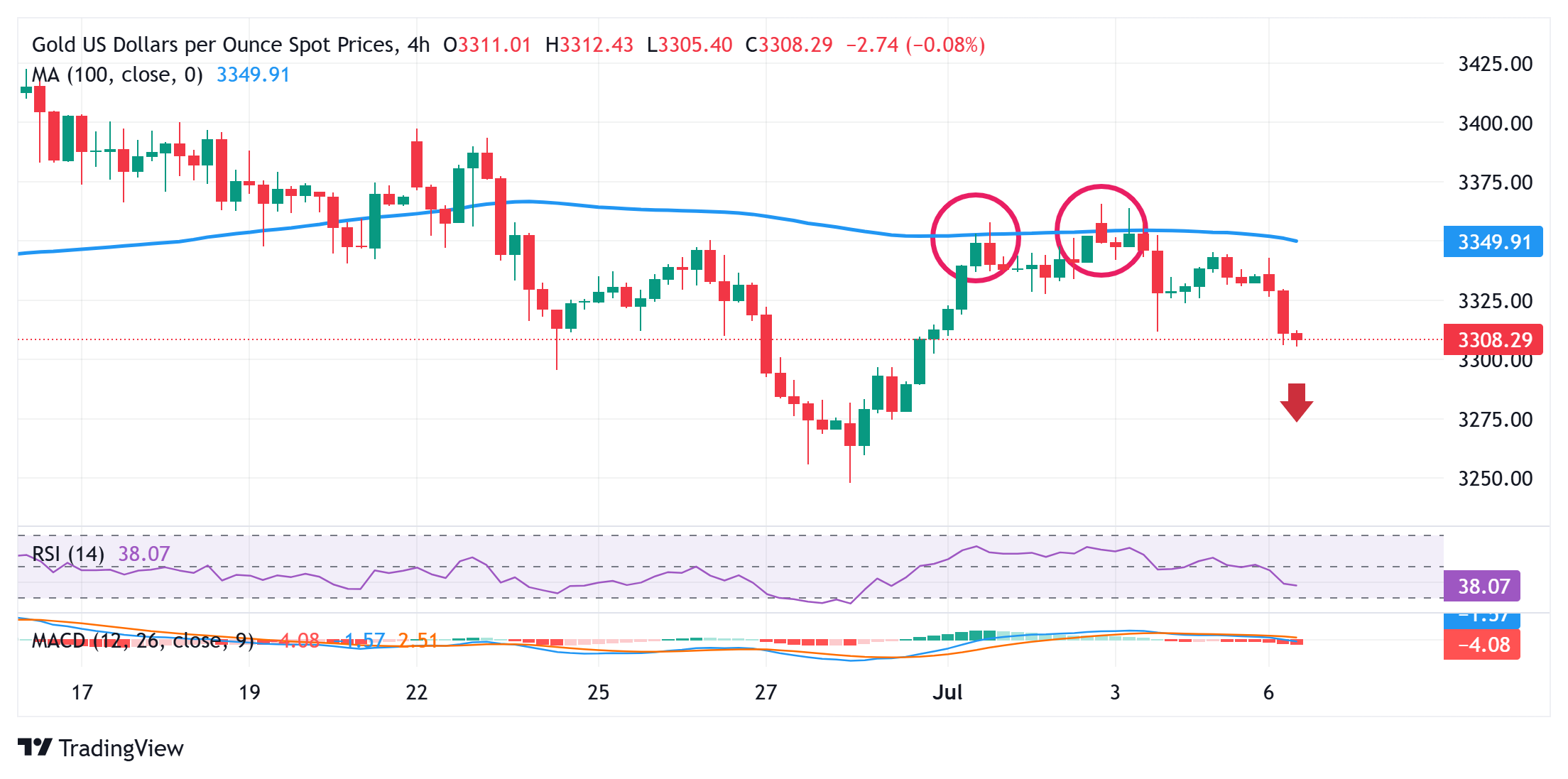- Gold price drops to a multi-day low on Monday amid modest USD strength.
- Fed rate cut bets and US fiscal concerns should act as a headwind for the USD.
- Geopolitical risks could further offer support to the safe-haven precious metal.
Gold price (XAU/USD) touches a fresh daily low during the early part of the European session on Monday, with bears now awaiting a sustained break below the $3,300 mark before positioning for deeper losses. The US Dollar (USD) regains positive traction and moves back closer to last week’s swing high, which, in turn, is seen as a key factor undermining the commodity. However, bets that the Federal Reserve (Fed) will resume its rate-cutting cycle in the near future should keep a lid on the USD and lend support to the non-yielding yellow metal.
Furthermore, concerns that US President Donald Trump’s massive tax-cut and spending bill would worsen America’s long-term debt problems might contribute to capping gains for the USD. Adding to this, fresh Israeli strikes on Yemen in almost a month, along with the uncertainty over Trump’s erratic trade policies, take their toll on the global risk sentiment and warrant some caution for the XAU/USD bears. Traders now look to the FOMC meeting minutes on Wednesday for cues about the Fed’s rate-cut path, which will drive the USD and the Gold price.
Daily Digest Market Movers: Gold price is pressured by a goodish pickup in the USD demand
- The US Dollar kicks off the new week on a slightly positive note and weighs on the Gold price, though the downside potential seems limited amid a combination of supporting factors.
- US President Donald Trump’s ‘One Big Beautiful Bill’ is now a law and is expected to add $3.4 trillion to the nation’s debt over the next decade, worsening the long-term debt problem.
- This comes amid worries about the potential economic fallout from Trump’s reciprocal tariffs and dovish Federal Reserve bets, which should keep a lid on any meaningful USD strength.
- Trump said on his social media early this Monday that the US tariff letters, and/or deals, with various countries from around the world, will be delivered starting 12:00 P.M. on July 7th.
- Trump followed up with a warning, stating that any country aligning with the anti-American policies of BRICS will be charged an additional 10% tariff and there will be no exceptions to this policy.
- Traders are currently pricing in over a 70% chance that the US central bank would lower borrowing costs in September and deliver at least two 25 basis points rate reductions by the year-end.
- The Israeli military carried out intense strikes on Houthi targets in three Yemeni ports and a power plant early this Monday in response to repeated attacks by the Iran-aligned group on Israel.
- This keeps geopolitical risks in play and should offer some support to the safe-haven precious metal. Traders now look to the release of FOMC minutes on Wednesday for a fresh impetus.
Gold price could accelerate the downfall once the $3,300 mark is broken decisively

The recent repeated failures to build on momentum beyond the 100-period Simple Moving Average (SMA) on the 4-hour chart and the subsequent fall below the $3,300 mark will be seen as a fresh trigger for the XAU/USD bears. Given that oscillators on the daily chart have just started gaining negative traction, the Gold price might then accelerate the slide to the next relevant support near the $3,270 horizontal zone en route to the $3,248-3,248 region.
On the flip side, the $3,324-3,325 region now seems to act as an immediate hurdle ahead of the $3,342-3,343 zone. Some follow-through buying, leading to a further strength beyond the $3,352-3,355 area, could provide a goodish lift to the Gold price and allow bulls to aim towards reclaiming the $3,400 round figure.
Fed FAQs
Monetary policy in the US is shaped by the Federal Reserve (Fed). The Fed has two mandates: to achieve price stability and foster full employment. Its primary tool to achieve these goals is by adjusting interest rates.
When prices are rising too quickly and inflation is above the Fed’s 2% target, it raises interest rates, increasing borrowing costs throughout the economy. This results in a stronger US Dollar (USD) as it makes the US a more attractive place for international investors to park their money.
When inflation falls below 2% or the Unemployment Rate is too high, the Fed may lower interest rates to encourage borrowing, which weighs on the Greenback.
The Federal Reserve (Fed) holds eight policy meetings a year, where the Federal Open Market Committee (FOMC) assesses economic conditions and makes monetary policy decisions.
The FOMC is attended by twelve Fed officials – the seven members of the Board of Governors, the president of the Federal Reserve Bank of New York, and four of the remaining eleven regional Reserve Bank presidents, who serve one-year terms on a rotating basis.
In extreme situations, the Federal Reserve may resort to a policy named Quantitative Easing (QE). QE is the process by which the Fed substantially increases the flow of credit in a stuck financial system.
It is a non-standard policy measure used during crises or when inflation is extremely low. It was the Fed’s weapon of choice during the Great Financial Crisis in 2008. It involves the Fed printing more Dollars and using them to buy high grade bonds from financial institutions. QE usually weakens the US Dollar.
Quantitative tightening (QT) is the reverse process of QE, whereby the Federal Reserve stops buying bonds from financial institutions and does not reinvest the principal from the bonds it holds maturing, to purchase new bonds. It is usually positive for the value of the US Dollar.

